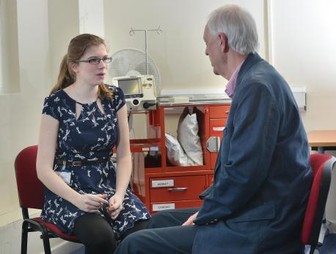Home
Funding Areas
About Us
There's a "kind of dry eye renaissance" under way, and it's all thanks to advances in diagnosis and treatment, according to a post at the American Academy of Ophthalmology.
"We've entered an era of innovative management for this common condition'a kind of dry eye renaissance,'" writes Dr. Nancy Kalish of the University of Maryland School of Medicine.
"Progress is essential because dry eye's incidence is growing....
It's also driven by our population's advancing age, irritants such as contact lens wear and extended screen time, and an awareness among patients that they don't have to live scratchiness, burning, or blurred vision."
Kalish notes that dry eye is on the rise not only because of the aging population, but also because of an increase in screen time and contact lens wear, as well as an awareness that those who don't have tears in their eyes don't have to live with them.
There are currently several treatments on the market for dry eye, but they're not always effective.
"Only by staying informed about the growing spectrum of products can we do our best to manage this intractable condition," Kalish writes.
There are currently no FDA-approved drugs for dry eye,
Selected Grant News Headlines
A customized collection of grant news from foundations and the federal government from around the Web.
'Safety, compassion, innovation': Beaufort Memorial honors top staff at Bemmy Awards.The Quality Services department took home the award for Department of the Year at BeaufortMemorial Hospital's...more
This ranking recognizes the leading children's hospitals in the U.S., featuring the top 50 hospitals.Cleveland Clinic Children's placed in all eight pediatric subspecialities: Cardiology and Cardiac...more
Mackinac Policy Conference left early childhood education off this year's agenda.By 2027, make Detroit a city that puts young children and families first, says James Ribbron, executive director of...more
Investing in tech to help children and communities thrive | Takeda Stories.How our Global CSR Program helped empower diverse entrepreneurs to innovate health solutions.29 Digital public goods...more
Greg Bourke is the author of "Gay, Catholic, and American: My Legal Battle for Marriage Equality and Inclusion" Bourke spoke at the Yale School of Management's Social Impact Lab.Bourke's final advice...more
Tesla plans to deploy a small fleet of robotaxis in Austin in the coming weeks.Tesla FSD 13.2.9 will still run a kid down while illegally blowing past a stopped school bus with red lights flashing...more
Awarded funding will support a wide range of activities between now and September 30, 2025.The FCCN initiative, supported by $85,000 in grant funding, will help build and sustain a Family Child Care...more
The Delivering Innovative Vocational Education through Virtual Reality Technology new workforce training program aimed at preparing individuals with disabilities for the program.DIVE-VRT delivers...more
Children are growing up surrounded by screens, apps, and smart devices.Being intentional about tech use goes a long way toward deepening interest in tech and creating meaningful experiences.Creating...more
Safeguarding innovation and trade secrets in American AI leadership Safeguarded innovation andtrade secrets in U.S.AI leadership.Testimony was given before the House Judiciary Subcommittee on Courts,...more
Children News from...
Becton, Dickinson and Company
Social Entrepreneurship
Spotlight
When it Comes to Social Enterprises, Failure is the Best Platform for Innovation

In the world of social enterprises, failure is a cringe-worthy moment nobody wants to talk about. But, social entrepreneurs can benefit from their failures.











